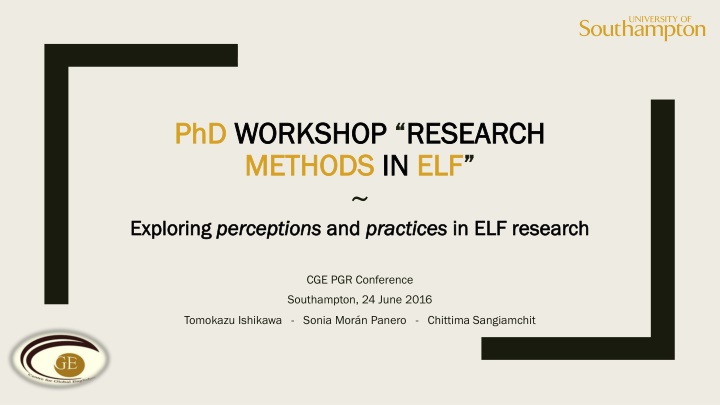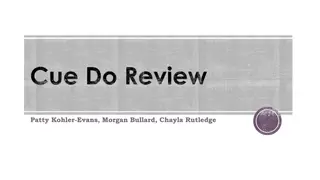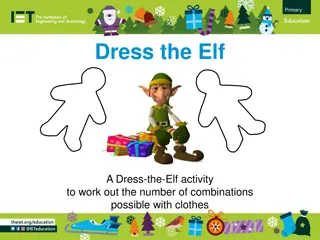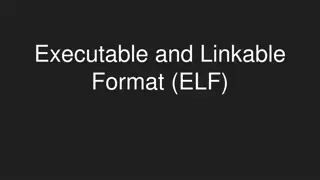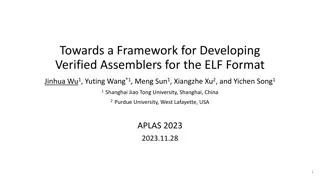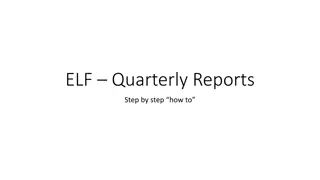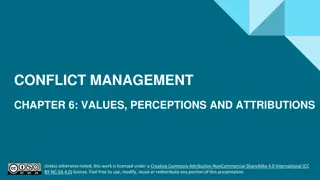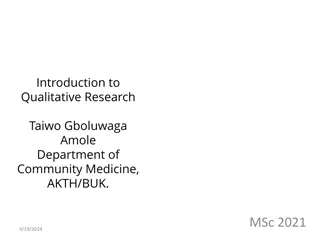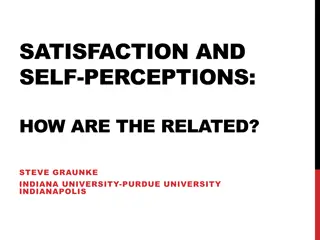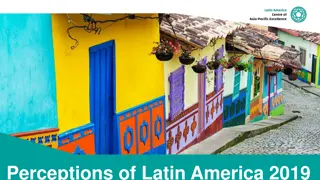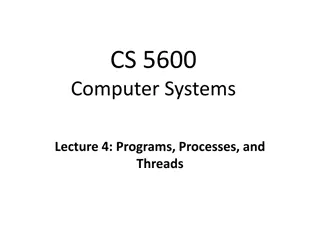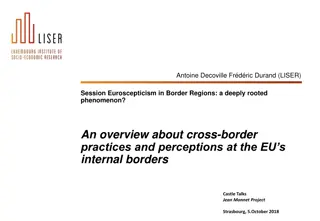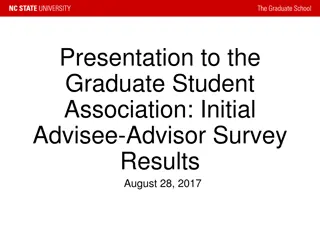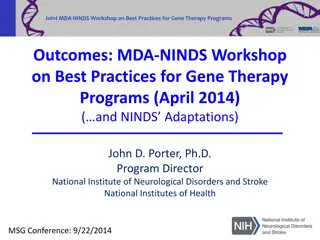Workshop on Research Methods in ELF: Exploring Perceptions and Practices
This workshop at the CGE PGR Conference focused on generating discussions around the suitability of different methodological approaches for researching perceptions and practices in English as a Lingua Franca (ELF). It aimed to identify emerging trends and future orientations in ELF research methods while considering the benefits and limitations of current approaches. Key areas of discussion included research purposes, analytical frameworks, methodological questions, and orientations.
Download Presentation

Please find below an Image/Link to download the presentation.
The content on the website is provided AS IS for your information and personal use only. It may not be sold, licensed, or shared on other websites without obtaining consent from the author.If you encounter any issues during the download, it is possible that the publisher has removed the file from their server.
You are allowed to download the files provided on this website for personal or commercial use, subject to the condition that they are used lawfully. All files are the property of their respective owners.
The content on the website is provided AS IS for your information and personal use only. It may not be sold, licensed, or shared on other websites without obtaining consent from the author.
E N D
Presentation Transcript
P Ph hD D WORKSHOP WORKSHOP RESEARCH METHODS METHODS IN ~ Exploring Exploring perceptions perceptions and and practices RESEARCH IN ELF ELF practices in ELF research in ELF research CGE PGR Conference Southampton, 24 June 2016 Tomokazu Ishikawa - Sonia Mor n Panero - Chittima Sangiamchit
Aims Aims of the workshop Generate discussion Generate discussion on the suitability explore particular aspects of the spread and use of ELF suitability of different methodological approaches to Reflect on potential benefits and limitations benefits and limitations of current dominant ELF research dominant methodologies in Identify emerging emerging methodological trends methodological trends or future orientations ( research? future orientations (to be followed) in ELF
Areas Areas of discussion Tomokazu Ishikawa Research Research purpose purpose Researching Researching Language Language perceptions perceptions Research Research Philosophy Philosophy Research Research Methods Methods Sonia Mor n Panero Analytical Analytical Framework Framework Observing Observing communicative communicative practices practices Chittima Sangiamchit Methodological questions and orientations
Proposed Proposed workshop questions 1. What are the limitations Qualitative/quantitative approaches Direct/indirect approaches Researcher roles in observation Closed/open forms of enquiry limitations and/or benefits benefits of researching ELF perceptions/practice through 2. To what extent is your methodological approach defined or influenced by research settings/sites settings/sites particular interests interests as a researcher the theorisation theorisation of your object of study object of study (e.g. perceptions/practices as cognitive, autonomous system or as emergent intersubjective practice) 3. Are either elicited language perceptions and/or practices in ELF? elicited or naturalistic data naturalistic data more or less desirable/informative/valid/feasible for the exploration of 4. Do you see any particular methodological orientation(s)/trend(s) methodological orientation(s)/trend(s) as the future exploring perceptions/practices in ELF? the future or most appropriate way of
Researching language perceptions: Researching language perceptions: In search of underlying evaluative concepts Tomokazu Ishikawa 24 June 2016 Southampton
Researching language perceptions: Research purpose and philosophy 1 Language attitudes as evaluative concepts Language attitudes as evaluative concepts identified with a reservoir of evaluative concepts directed to a linguistic phenomenon ( Japanese people s English) underlying observable responses which are constructed situationally Niedzielski and Preston s (e.g., 1999/2003) folk linguistics Preston s (2010) conceptual reservoir conceptual reservoir + social psychological perspectives + social psychological perspectives (e.g., Rosenberg and Hovland 1960; Campbell 1963; Petty et al. 1997; Eagly and Chaiken 2007; Perloff 2014) folk linguistics / Tomokazu Ishikawa (ti1g12@soton.ac.uk)
Researching language perceptions: Research purpose and philosophy 2 Language attitudes as evaluative concepts Language attitudes as evaluative concepts identified with a reservoir of evaluative concepts STABLE directed to a linguistic phenomenon ( Japanese people s English) underlying observable responses which are constructed situationally FLEXIBLE The stability and flexibility of attitudes represent two sides of the same coin (Ishikawa PhD thesis) Tomokazu Ishikawa (ti1g12@soton.ac.uk)
Researching language perceptions: Research methods 1 Three possible approaches Three possible approaches (e.g., Garrett 2010) societal treatment societal treatment: how languages/language varieties and their users are viewed in a society e.g. language policy documents, consumer advertisements, linguistic landscape Limitation: not sufficient in many research enquiries indirect approach indirect approach direct approach direct approach Tomokazu Ishikawa (ti1g12@soton.ac.uk)
Researching language perceptions: Research methods 2 Indirect approach Indirect approach The matched guise technique (MGT) and the verbal The matched guise technique (MGT) and the verbal guise technique (VGT) guise technique (VGT) the respondents are deceived into thinking that the researchers are investigating attitudes other than those that they are actually researching (Garrett et al. 2003: 17) e.g. respondents: evaluating people vs. the researcher: language varieties Tomokazu Ishikawa (ti1g12@soton.ac.uk)
Researching language perceptions: Research methods 3 Indirect approach: The MGT Indirect approach: The MGT (e.g., Lambert et al. 1960) the same audio text in various languages/language varieties the same speaker(s) under guises a questionnaire with rating scales (e.g. pleasant 1 2 3 4 5 6 7 unpleasant) Limitations stereotypes, representativeness (e.g., Jenkins 2007) non-spontaneous speech, practicality (e.g., McKenzie 2010) Tomokazu Ishikawa (ti1g12@soton.ac.uk)
Researching language perceptions: Research methods 4 Indirect approach: The VGT Indirect approach: The VGT (e.g., Gallois and Callan 1981) actual speakers of each language/language variety a questionnaire with rating scales Limitations speech factors (e.g., Jenkins 2007) variety recognition (e.g., McKenzie 2010) stereotypical MGT/VGT samples imposed (e.g., Ishikawa PhD thesis) Tomokazu Ishikawa (ti1g12@soton.ac.uk)
Researching language perceptions: Research methods 5 Direct approach Direct approach Questionnaire and interviews Questionnaire and interviews the asking of direct questions about language evaluation, preference etc. (Garrett et al. 2003: 16) Tomokazu Ishikawa (ti1g12@soton.ac.uk)
Researching language perceptions: Research methods 6 Direct approach: Questionnaire Direct approach: Questionnaire Rating scales and other closed Rating scales and other closed- -response items Coupland and Bishop 2007) The standard method of analyzing quantitative questionnaire data involves submitting them to various statistical procedures (D rnyei and Taguchi 2010: 96) Limitation: confined to predetermined categories (Garrett et al. 2003: 35) response items (e.g., Tomokazu Ishikawa (ti1g12@soton.ac.uk)
Researching language perceptions: Research methods 7 Direct approach: Questionnaire Direct approach: Questionnaire Perceptual dialectology Perceptual dialectology (e.g., Long and Preston 2002) to label maps with where different dialects are spoken, or to rate various areas on how correct and pleasant the language spoken there is (Lindemann 2005: 189) Limitation: constrained to respond geographically Tomokazu Ishikawa (ti1g12@soton.ac.uk)
Researching language perceptions: Research methods 8 Direct approach: Questionnaire Direct approach: Questionnaire Open Open- -ended questionnaire ended questionnaire (e.g., Evans and Imai 2011 [2 items]) questionnaires are unsuitable for probing deeply into an issue (D rnyei and Taguchi 2010: 7) Jenkins (2014) open-ended email questionnaire [10 items] respondents capability to express themselves in written words relevance of the theme to them Tomokazu Ishikawa (ti1g12@soton.ac.uk)
Researching language perceptions: Research methods 9 Direct approach: Interviews Direct approach: Interviews Unstructured interviews as casual conversations Unstructured interviews as casual conversations (e.g., Jenkins 2014) Casual conversations (Eggins and Slade 1997/2004) unpredictable flow and only vaguely around the research focus dynamic, sometimes humorous, interaction accompanied by occasional smiles and laughter relatively long Tomokazu Ishikawa (ti1g12@soton.ac.uk)
Researching language perceptions: Analytical frameworks 1 Qualitative content analysis Qualitative content analysis to capture the underlying structures of surface-level accounts (e.g., Berg and Lune 2012) coding, categorising and interpreting (e.g., Schreier 2012) Limitation(?): Influenced by the research focus and interests (e.g., Miles et al. 2014) Tomokazu Ishikawa (ti1g12@soton.ac.uk)
Researching language perceptions: Analytical frameworks 2 Eggins and Slade s (1997/2004) speech functions Eggins and Slade s (1997/2004) speech functions analysis framework analysis framework each interviewee s stance and concerns: his/her initiating moves, variously occurring expansion, and confronting responses or rejoinders meanings of conversational moves applicable to both original and translated data Tomokazu Ishikawa (ti1g12@soton.ac.uk)
Researching language perceptions: Summary Answers to workshop questions Answers to workshop questions Q1 indirect approach: stereotypical samples imposed closed-response items: confined to predetermined categories Q2 research setting: appropriate for an email questionnaire flexible expressions open-ended questionnaire and conversational interviews stable underlying concepts qualitative content analysis (+ Eggins and Slade s framework) influenced by the research focus and interests Q3 elicited vs. naturalistic : not dichotomous Tomokazu Ishikawa (ti1g12@soton.ac.uk)
Researching language perceptions: Selected references D rnyei, Zolt n & Tatsuya Taguchi. 2010. Questionnaires in second language research: Construction, administration, and processing, 2nd edn. London: Routledge. Eggins, Suzanne & Diana Slade. 1997/2004. Analysing casual conversation. London: Equinox. Garrett, Peter. 2010. Attitudes to language. Cambridge: Cambridge University Press. Garrett, Peter, Nikolas Coupland & Angie Williams. 2003. Investigating language attitudes: Social meanings of dialect, ethnicity and performance. Cardiff: University of Wales Press. Jenkins, Jennifer. 2007. English as a Lingua Franca: Attitude and identity. Oxford: Oxford University Press. Jenkins, Jennifer. 2014. English as a Lingua Franca in the international university: The politics of academic English language policy. London: Routledge. Lindemann, Stephanie. 2005. Who speaks broken English ?: US undergraduates perceptions of non-native English. International Journal of Applied Linguistics 15(2). 187 212. McKenzie, Robert M. 2010. The social psychology of English as a global language: Attitudes, awareness and identity in the Japanese context. Dordrecht: Springer. Miles, Matthew B., A. Michael Huberman & Johnny Salda a. 2014. Qualitative data analysis: A methods sourcebook, 3rd edn. London: Sage. Niedzielski, Nancy A. & Dennis R. Preston. 1999/2003. Folk linguistics. Berlin: Mouton de Gruyter. Preston, Dennis R. 2010. Variation in language regard. In Peter Gilles, Joachim Scharloth & Evelyn Ziegler (eds.), Variatio delectat: Empirische Evidenzen und theoretische Passungen sprachlicher Variation, 7 27. Frankfurt am Main: Peter Lang. Schreier, Margrit. 2012. Qualitative content analysis in practice. London: Sage. Tomokazu Ishikawa (ti1g12@soton.ac.uk)
Exploring the construction of orientations towards ELF as social practice Sonia Mor n Panero 24 June 2016 Southampton smp1e08@soton.ac.uk
Research Research Aims Aims (Non-linguistics) undergraduate s orientations (i.e. conceptualisations conceptualisations and evaluations evaluations) to Meanings Variability Values Fixity Functions ELF Evaluations English as a global resource English as a global resource a labelled language a labelled language Ways of speaking English Ways of speaking English The use of language and communication constructs constructs in the formulation formulation of perceptions the ideological ideological work performed in the accounts
Research Research Methods Methods
A direct and qualitative approach: A direct and qualitative approach: elicited elicited metalanguage metalanguage Observe what constructs/ concepts/labels are used or rejected in accounts Observe what meanings and evaluations are assigned to these by participants Capturing complexity and variability of social meaning assignation and evaluation 24
Ontological and epistemological principles Ontological and epistemological principles informing the methodological approach informing the methodological approach
Situationality and variability of the object of evaluation Situationality and variability of the object of evaluation ELF as emergent and fluid social practice/language ELF as emergent and fluid social practice/language- -in in- -use al., 2014; Jenkins, 2015) use (see Baird et an attitude is an evaluative orientation to a social object whether it is a language a language, , or a new government policy, etc. (Garret, 2010: 20) object of some sort, shared? known? fixed? shared? known? fixed? C Conceptualisation of the object as onceptualisation of the object as potentially potentially variable / non variable / non- -shared shared if we want to understand why understand understand their why a person has offered a specific opinion a person has offered a specific opinion, we need to their social representation social representation of the object being considered (Potter, 1996: 139) need to 26
Phenomenological and indexical principles Phenomenological and indexical principles Indexicality Indexicality studies understanding of social meaning as multi-dimensional, non-linear, variable variable, unstable unstable and context context- -dependen dependent (e.g. Blommaert, 2014; Coupland, 2007: 99) social meaning ocial meaning & & evaluations evaluations not not inherent inherent in in particular linguistic features (e.g. Coupland, 2007; Eckert, 2012; Kitazawa, 2013) mediated by ideologically ideologically constructed representations of difference (Irivine and Gal, 2000; 2009: 375) Folk Linguistics phenomenological Folk Linguistics phenomenological approach and pursuit of folk ontologies language (e.g. Preston, 1994; 2002; Niedzielski and Preston, 2009:356). ontologies of
Evaluation as (situationally variable) social action Evaluation as (situationally variable) social action Discursive psychology s Discursive psychology s evidence of intra intra- -speaker speaker variability of evaluative practices variability of evaluative practices discursive practices performed constant construction & negotiation It is not is not something they start with not something they start with (Potter, 2012: 442), nor something that they see as causal of social behaviour . not that discursive psychologists do not consider thinking thinking, cognition cognition, mind mind, feelings feelings and so on, but this causal underpinning Foci of analysis Foci of analysis accessing or measuring attitudinal products vs Process of attitude construction Actions performed through evaluative practice (e.g. Kamberelis and Dimitriadis, 2011; Liebscher and Dailey-O Cain, 2009; Parker, 2005; Potter, 1998, Wetherell, 1998)
Analytical framework: Analytical framework: a layered approach a layered approach
Interview analysis: codes & interpretative repertoires Interview analysis: codes & interpretative repertoires Qualitative content and topic coding Top-down topics, functions, meanings, issues about English/ELF Bottom-up topics, functions, meanings, issues about English/ELF coding (Salda a, 2016) Identifying interpretative repertoires interpretative repertoires (see also Hynninen, 2013; Studer, 2014) a lexicon lexicon or register of terms or register of terms and metaphors actions and events (Potter and Whetherell, 1987: 138 ) metaphors drawn upon to characterize and evaluate the basis for launching descriptions, evaluations and justifications basis for launching descriptions, evaluations and justifications in a given context (Whetherell, 1998: 406). A way of exploring the social and political consequences social and political consequences of discursive patterning (Wetherell, 1998: 410) and how situated talk is embedded in wider historical contexts and sedimentation processes of ideological representation ideological representation (Edley, 2001)
Contributions, controversies and limitations Contributions, controversies and limitations Diminish essentialising interpretations of studied phenomena Elicited data / naturalistic data Elicited data / naturalistic data Partiality Partiality of repertoires identified in specific context context in specific Identifying conceptual and evaluative repertoires available to interpret and construct experiences with English Generalisability and sharedness claims (?) Identifying language ideologies available and ideological reproduction, challenging, rejection, negotiation Immediacy of talk vs. macro-level interpretation Identifying variability and multiplicity of Identifying variability and multiplicity of understandings understandings across across and participants participants and within within Particular context, interest or identities discussed/invoked
Trends Trends in in perceptual perceptual studies of ELF? studies of ELF? exploring attitudes towards different varieties of English varieties of English and their preferences over one or the other , with ELF being among them (Hynninen, 2013: 52), different consider[ing] how and what they expectit to be like (Hynninen, 2013: 53, my italics) how ELF users describe describe ELF ELF ELF1 ELF1 influences (see Jenkins, 2015)? Pre-defined linguistic terms/boundaries Code oriented Seeking legitimacy ELF 2 ELF 2 influences (see Jenkins, 2015)? Speaker oriented Observing processes of linguistic definition and social practice functions Observing processes of (de)legitimisation in ELF interactions What should the study of What should the study of perceptions in in ELF3 ELF3 ? ? (i.e. English as a multilingua franca in Jenkins, 2015) perceptions look like look like methodologically methodologically
References I Baird R., Baker, W. and Kitazawa, M. 2014. The complexity of ELF. Journal of English as a Lingua Franca 3/1: 171-196 Blommaert, J. M. E. 2014. Meaning as a nonlinear phenomenon: The birth of cool. Tilburg Papers in Culture Studies, 106: 1-20 Coupland, N. 2007. Style: language variation and identity. Cambridge: Cambridge University Press. Eckert P. 2012. Three waves of variation study: The emergence of meaning in the study of sociolinguistic variation. Annual Review of Anthropology. 41. 87-100. Edley, N. 2001. Analysing Masculinity: Interpretative Repertoires, Ideological Dilemmas and Subject Positions. In Whetherell, M. Taylor, S. and Yates, S. J. (eds) Discourse as Data. A guide for Analysis. London: Sage Publications, pp. 180-228 Garrett, P. 2010. Attitudes to Language. Cambridge: Cambridge University Press. Hynninen, N. 2013. Language regulation in English as a Lingua Franca: Exploring language-regulatory practices in academic discourse. Unpublished doctoral thesis. University of Helsinki Irvine, J. and Gal, S. 2000. Language Ideology and Linguistic Differentiation. In Kroskity, P. V. (ed). Regimes of Language: Language Ideologies, Polities, and Identities. New Mexico: School for American Research Press, pp. 35-79 Irvine, J. and Gal, S. 2009. Language-Ideological Processes. In Coupland, N. and Jaworski, A. (eds) The new sociolinguistics reader. Basingstoke: Palgrave Macmillan, pp. 375-377 Kamberelis G. and Dimitriadis, G. 2011. Focus Groups: Contingent Articulations of Pedagogy, Politics, and Inquiry in Denzin, N. Y. and Lincoln, Y. S. (eds) The Sage Handbook of Qualitative Research. London: Sage Jenkins, J. 2015. Repositioning English and Multilingualism in English as a Lingua Franca . Englishes in Practice, 2(3): 49-85
References II Kitazawa, M. 2013. Approaching conceptualisations of English in East Asian contexts : ideas, ideology, and identification. Unpublished doctoral thesis. University of Southampton Liebscher G. and Dailey-O Cain, J. 2009. Language attitudes in interaction. Journal of Sociolinguistics. 13/2: 195- 222 Parker, I. 2005. Qualitative Psychology: Introducing radical research. Buckingham, UK: Open University Press. Potter, J. 1996. Attitudes, social representations, and discursive psychology. In M. Wetherell, (Ed.) Identities, Groups and Social Issues London: Sage. pp. 119-173. Potter, J. 1998. Discursive social psychology: From attitudes to evaluations, European Review of Social Psychology, 9, 233-266. Potter, J. 2012. Discursive Psychology and Discourse Analysis. In Hamford, M. Gee, J.P. The Routledge Handbook of Discourse Analysis. London: Routledge Potter, J. and Wetherell, M.1987. Discourse and social psychology: beyond attitudes and behaviour. London: Sage Preston, D. R.1994. Content-oriented Discourse Analysis and Folk Linguistics. Language Sciences, 16/2: 285-331 Preston, D. R. 2002. Language with an Attitude in J. K. Chambers, P. Trudgill and N. Schilling-Estes (eds), The Handbook of Language Variation and Change, Oxford: Blackwell. Salda a, J. 2016. The Coding Manual for Qualitative Researchers. London: Sage Studer, P. 2014. Coping with English: students perceptions of their teachers linguistic competence in undergraduate science teaching. International Journal of Applied Linguistics: 1-19 Wetherell, M. 1998. Positioning and interpretative repertoires: Conversation analysis and poststructuralism in dialogue. Discourse and Society, 9/3 :387 412
Observation language practices through ELF Chittima Sangiamchit 24 June 2016 Southampton
Aims: ELF in modern Aims: ELF in modern online context online context Cultural representation and cultural construction Online Online context: SNSs context: SNSs (Facebook) (Facebook) ICCs Perceptions
Multi-methodological approaches Online questionnaire Online questionnaire Online context Online context - - Research Research setting and setting and site: site: FACEBOOK FACEBOOK Online Online observation observation Interviews Interviews Focus group Focus group
Observation in my ELF online study To investigate in what ways participants represent and construct their culture(s) through ELF in their interactions online. To discover unspoken issues during the interviews or group discussion (Cohen, et at, 2011). To cover data which is limited to participants memory, communicative ability, unnoticed issues, and only issues they prefer to talk about (D rnyei, 2007; Cohen, et at, 2011). To promote cross-checking in that what people do may differ from what they say they do. (Robson, 2002).
Types of observation in my ELF online study The participant The participant- -as To observe online conversations of the participants in their Facebook s walls. My status was overt to the participants since acceptance as a member of their online groups was needed. I blended into the medium in order to observe and record all participants conversations with their interlocutors from different lingua- cultural backgrounds without disturbing or joining their interactions. I can gather rich description and get a feel of participants interactions as all their interactions were closely observed and I became familiarized with how they communicated and represented and constructed their culture(s) as well as how they coped with the situations when communicative problems occurred. as- -observer observer
Types of observation in my ELF online study The observer The observer- -as To collect data from participants private messages in Facebook. I was not a member of the group but known as a researcher. The participants emailed their conversation records to me directly. The participants interlocutors needed to consent to the observation of their private conversations. as- -participant participant
Encountered limitations of observation in my ELF online study The lack of interpersonal relations between the researcher and participants which result in the limited number of research participants. It is difficult to approach interlocutors of the participants and ask for their explanation about the communicative meanings (which possibly contain different point of views to the participants), regarding to these important factors, i.e. the lack of interpersonal relationship between the researcher and the participants interlocutors, the variety of the participants interlocutors without their contact information, their unavailability to take part in a research observation.
Analytical frameworks for the observational method in my ELF online study Content Content analysis To describes patterns and trends in communicative contents and reveals main ideas and/or attitudes of participants through systematic and recursive coding (Cohen, et al, 2011). A total of 139 scripts or 209 Microsoft word pages of online conversation records were collected. Preconceived codes consist of three main categories based on research questions, including the roles of cultures , intercultural communicative competence , and perceptions of English use for online intercultural communication . There are also interesting data emerged during coding process about cultural and language use for online intercultural communication, consisting of cultural (and language) fluidity , languagechoices , and culturalcomparison . analysis
Analytical frameworks for the observational method in my ELF online study Multimodal Multimodal analysis is an inter-disciplinary approach to understand communication and representation as more than language and attends systematically to the social interpretation of a range of forms of making meaning (Jewitt, 2016). Social semiotic multimodal analysis mapping how modal resources are used by people in a given community/ social context, in other words sign-making as a social process (Jewitt, 2009). analysis
References Cohen, Louis; Manion, Lawrence; Morrison, Keith. (2011). Research methods in education (7th edition). Oxon. Routledge. D rnyei, Z. (2007). Research methods in applied linguistics: Quantitative, qualitative and mixed methodologies. Oxford: Oxford University Press. Jewitt, Carey. (2009). The Routledge handbook of multimodal analysis. Oxon. Routledge. Jewitt, Carey. (2016). Multimodal analysis. In Georgakopoulou, A. and Spilioti, T. (2016). The Routledge Handbook of Language and Digital Communication. Oxon. Routledge. Robson, Colin. (2002). Real world research (2nd edition). Oxford: Blackwell.
